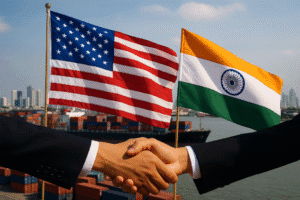US-India Trade Deal Shock: 7,000 Tariffs & 5 Major Risks That Could Derail Talks
A comprehensive US-India trade pact remains distant, with US Commerce Secretary Howard Lutnick citing the daunting task of aligning 7,000 tariff lines. While India seeks progress through upcoming talks led by Chief Negotiator Rajesh Agrawal, the US points to its recent UK deal—a model balancing sectoral reciprocity (e.g., Rolls-Royce engines for Boeing planes)—as a template. Washington’s focus on reducing India’s $28 billion trade surplus could pressure New Delhi to slash tariffs on US agricultural exports and luxury vehicles, mirroring concessions made to the UK.
However, India faces domestic risks: tariff cuts on farm goods may anger its vast agricultural workforce, while digital trade terms could undermine local tech ambitions. Experts urge caution, emphasizing sovereignty over rushed deals. Strategically, the US aims to counterbalance China in Asia through such pacts, but India’s non-aligned stance complicates alignment. Success hinges on mutual flexibility, balancing US market access demands with India’s developmental priorities, amid lingering disputes over tariffs and regulations.

US-India Trade Deal Shock: 7,000 Tariffs & 5 Major Risks That Could Derail Talks
The prospect of a comprehensive trade deal between the U.S. and India remains uncertain, with U.S. Commerce Secretary Howard Lutnick emphasizing the sheer scale of negotiations required. Speaking on a recent Bloomberg podcast, Lutnick acknowledged India’s proactive engagement but highlighted the daunting task of aligning “7,000 tariff lines”—a process he cautioned would demand time and meticulous effort. This comes as an Indian delegation, led by Chief Negotiator Rajesh Agrawal, prepares to visit Washington later this month to advance discussions.
The Blueprint from the US-UK Deal
Lutnick pointed to the recently finalized U.S.-UK trade agreement as a potential model. That deal prioritized sector-specific compromises, such as the UK securing access for Rolls-Royce engines in Boeing aircraft in exchange for purchasing $10 billion worth of U.S.-made planes. Such sectoral reciprocity, Lutnick suggested, could inform future pacts, including with India. The approach underscores a broader U.S. strategy: address trade imbalances by opening markets while protecting domestic industries through targeted tariff adjustments.
India’s Delicate Balancing Act
For India, negotiations present both opportunity and risk. The U.S. is India’s largest trading partner, with bilateral goods trade hitting $118 billion in 2022–23. However, India’s trade surplus ($28 billion) has long been a sticking point for Washington. Analysts speculate the U.S. may push for concessions mirroring those in India’s recent UK pact, such as slashing tariffs on agricultural goods (soybeans, almonds, ethanol) and luxury automobiles. New Delhi’s decision to reduce duties on select UK vehicles from 100% to 10% sets a precedent the U.S. could leverage.
Yet India faces domestic pressures. Agriculture, a sector employing nearly 40% of the workforce, remains politically sensitive. Tariff cuts on American farm products could spark backlash from farmers, a vocal voting bloc. Similarly, concessions on digital trade or intellectual property might clash with India’s push for self-reliance in tech and pharmaceuticals.
Expert Warnings: Sovereignty Over Speed
Ajay Srivastava of the Global Trade Research Initiative (GTRI) urges caution. He argues India should prioritize a “balanced, sovereign approach” rather than rushing into a “mini-deal” focused solely on tariff reductions. “If the U.S. insists on one-sided terms—opening India’s markets without addressing non-tariff barriers or visa restrictions for Indian professionals—walking away may be wiser,” he says. Srivastava also highlights risks to India’s digital economy, where U.S. tech giants dominate, and urges safeguards for local startups.
Strategic Implications for Asia
Lutnick hinted that a U.S.-India pact could serve as a template for broader Asian engagement, signaling Washington’s intent to counterbalance China’s regional influence. However, India’s historic aversion to alliances complicates this vision. New Delhi may resist overtly aligning with U.S. strategic goals, preferring instead to retain autonomy in its foreign policy.
The Road Ahead
While both nations stand to gain—the U.S. through reduced deficits and India via access to advanced technologies and investments—the path forward is fraught. Trust deficits linger, exacerbated by past disputes over poultry tariffs and India’s data localization rules. Success hinges on mutual flexibility: the U.S. must acknowledge India’s developmental needs, while India may need to recalibrate its protectionist stance in critical sectors.
As negotiations resume this month, the stakes extend beyond economics. A fair, equitable deal could cement a transformative partnership. Conversely, a rushed or imbalanced agreement risks deepening skepticism in both capitals. For now, patience—not political posturing—will define progress.
You must be logged in to post a comment.